When thinking about future technology it’s easy to get caught in the sprawling landscape created by science fiction. But what of the reality – away from the armies of killer robots, flying cars and more armies of killer robots? What are the devices of the future that are going to impact on businesses in our lifetime?
Technology is moving fast – consumer and business tech are merging, where the two are barely separable. The 3rd Platform is changing the way we interact with everything, as all the major forces in IT – cloud, social media, mobile and big data – converge. And it’s the 3rd Platform that’s enabling us to start delivering context appropriate information.
And the devices of the future will cater to this, with manufacturers creating them to be context aware, enabling us to deliver information in the most accessible way to people depending on their situation, preference and attitude. This, in turn, fuels the possibilities for remote working – truly allowing people to work from anywhere, at any time.
Flexible devices (like those being developed by Samsung) and gestural control and recognition, which is being developed by HP, are a starting point and will no doubt populate the near future. But there are things further off that could truly allow us to put content and context at the forefront of IT information delivery. Here are some of the technologies that your users might be interacting with in the future.
SENSORS
Sensors are already everywhere. Cars, hospitals, phones – sensors are all around us. The fitness industry is being driven forward by sensor-led technology, as people attempt to improve their health by analysing data about their physical performance. The mHealth movement is pushing the boundaries in regards to how medical professionals interact with patients, removing geography and immobility as obstacles to care by creating sensors that can be attached to consumer smartphones. From a business perspective, using sensors can be key to finding out more about employees in order to deliver information appropriately
Using sensors like GPS, accelerometers, heart-monitors and others can give information about a user’s situation, preference and attitude – the three pillars of context. Know these things and you know how to deliver information appropriately.
But companies can move beyond this in the future and use sensors to help boost productivity and increase collaboration between employees, while also predicting their effectiveness in business situations. Sociometric Solutions, a spin-off from MIT’s Media Lab, specialises in providing companies with social analytics, by measuring and analysing how people interact with each other.
Using sensor packed ID badges the company measures employees movements, tone of voice, whoever they’re talking to and their geographical positional in the office. Through analysing the data gained from the ID badges, Sociometric Solutions can decipher how effective someone might be in a pitch or a presentation by looking at tone of voice, plus speaking volume and speed. The company also predicts that it can use its sensor badges to organise the make-up of an organisation, by using an analytical engine to decipher which colleagues should collaborate and meet. This would create an augmented social reality that feeds off social analytics.

WEARABLE TECHNOLOGY
Wearable technology is already well into development and is starting to creep into the hands of consumers. Smartwatches, like the Pebble, offer people functionality far beyond what they’re used to in the average watch, while companies like Under Armour are developing touch screens that can be built into fabric. Then, of course, you haveGoogle Glass – a product that could bring on the onset of annotated reality.
If wearable tech becomes an accessible reality, it will change the way we think of ‘dressing for work’. The prospect of an enterprise providing data through wearable devices that offer annotated reality opens up a world of possibilities for delivering appropriate context sensitive information. Tie wearable tech in with sensor technology and enterprises will gain real insight into how employees work and how to help them work smarter.
TACTILE TECHNOLOGY
Most of us carry tactile technology around in our pockets every day, now that touch screens have become the norm on smartphones. But what if your entire desk could be used as a computer; or your phone could assess your mood simply through the way you were holding it; or you could interact with just about any surface you came in contact with.
The principles of tactile tech isn’t a world away from the idea behind invoked computing. But while invoked computing allows people to turn everyday objects into devices that can be used to access information, (pizza box laptops and banana phones, for example) tactile technology turns everything that utilises it into an interface that can analyse interaction.
Companies like Tactonic Technologies are working towards making this tech an everyday reality and, in the future, it could become essential both in the workplace and for remote workers. When combining the kind of technology that’s being developed by Tactonic – it creates rectangular precision pressure tiles that can measure finger position to within one-hundredth of an inch and can sense 4,096 levels of pressure – with touchscreen technology, you have the ability to send and display information on almost any surface, as well as measure how people are interacting with it. Not only that, you can analyse how people are interacting with objects that don’t deliver information – how they sit in chairs and how they grip phones, for instance – gives companies information about the mood of their employees and whether they can make their working environment better, whether it’s office based or remote.
DELIVERING INFORMATION
All of this future technology is in development and has the potential to play an important part in all of our lives. What’s more though, it shows that companies are working towards developing ways of delivering information that doesn’t just take context and appropriateness into account, but puts them at the forefront of the technology.
Future Tech




